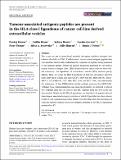Files in this item
Tumour-associated antigenic peptides are present in the HLA class I ligandome of cancer cell line derived extracellular vesicles
Item metadata
| dc.contributor.author | Kumar, Pankaj | |
| dc.contributor.author | Boyne, Caitlin | |
| dc.contributor.author | Brown, Sydney Erin | |
| dc.contributor.author | Qureshi, Ayesha | |
| dc.contributor.author | Thorpe, Peter Jacob | |
| dc.contributor.author | Synowsky, Silvia Anna | |
| dc.contributor.author | Shirran, Sally Lorna | |
| dc.contributor.author | Powis, Simon John | |
| dc.date.accessioned | 2022-04-21T09:30:50Z | |
| dc.date.available | 2022-04-21T09:30:50Z | |
| dc.date.issued | 2022-06-01 | |
| dc.identifier | 278370124 | |
| dc.identifier | 4cb52635-4ea5-4c66-a989-09ff1904086a | |
| dc.identifier | 000789523400001 | |
| dc.identifier | 85128414017 | |
| dc.identifier.citation | Kumar , P , Boyne , C , Brown , S E , Qureshi , A , Thorpe , P J , Synowsky , S A , Shirran , S L & Powis , S J 2022 , ' Tumour-associated antigenic peptides are present in the HLA class I ligandome of cancer cell line derived extracellular vesicles ' , Immunology , vol. 166 , no. 2 , 13471 , pp. 249-264 . https://doi.org/10.1111/imm.13471 | en |
| dc.identifier.issn | 0019-2805 | |
| dc.identifier.other | ORCID: /0000-0003-4218-2984/work/111970908 | |
| dc.identifier.other | ORCID: /0000-0003-3516-3507/work/111971496 | |
| dc.identifier.uri | https://hdl.handle.net/10023/25221 | |
| dc.description | Funding: Breast Cancer Now (Grant Number(s): 2018JulPR1086), Wellcome Trust (GrantNumber(s): 105621/Z/14/Z), Melville Charitable Trust. | en |
| dc.description.abstract | The recent success of monoclonal antibody checkpoint inhibitor therapies that enhance the ability of CD8+ T cells to detect cancer-related antigenic peptides has refocused the need to fully understand the repertoire of peptides being presented to the immune system. Whilst the peptide ligandome presented by cell surface human leucocyte antigen class I (HLA-I) molecules on cancer cells has been studied extensively, the ligandome of extracellular vesicles (EVs) remains poorly defined. Here we report the HLA-I ligandome of both the cell surface and EVs from eight breast cancer cell lines (MCF7, MDA-MB-231, MDA-MB-361, MDA-MB-415, MDA-MB-453, HCC 1806, HCC 1395, and HCC 1954), and additionally the melanoma cell line ESTDAB-056 and the multiple myeloma line RPMI 8226. Utilising HLA-I immunoisolation and mass spectrometry, we detected a total of 6574 peptides from the cell surface and 2461 peptides from the EVs of the cell lines studied. Within the EV HLA-I ligandome, we identified 150 peptides derived from tumour associated antigenic proteins, of which 19 peptides have been shown to elicit T cell responses in previous studies. Our data thus shows the prevalence of clinically relevant tumour-associated antigenic peptides in the HLA-I ligandome presented on EV. | |
| dc.format.extent | 15 | |
| dc.format.extent | 2318330 | |
| dc.language.iso | eng | |
| dc.relation.ispartof | Immunology | en |
| dc.subject | Extracellular vesicles | en |
| dc.subject | Tumour associated antigen (TAA) | en |
| dc.subject | HLA ligandome | en |
| dc.subject | T-cell epitopes | en |
| dc.subject | Breast cancer | en |
| dc.subject | QR180 Immunology | en |
| dc.subject | DAS | en |
| dc.subject | SDG 3 - Good Health and Well-being | en |
| dc.subject | MCC | en |
| dc.subject.lcc | QR180 | en |
| dc.title | Tumour-associated antigenic peptides are present in the HLA class I ligandome of cancer cell line derived extracellular vesicles | en |
| dc.type | Journal article | en |
| dc.contributor.sponsor | The Wellcome Trust | en |
| dc.contributor.institution | University of St Andrews. School of Medicine | en |
| dc.contributor.institution | University of St Andrews. Cellular Medicine Division | en |
| dc.contributor.institution | University of St Andrews. St Andrews Bioinformatics Unit | en |
| dc.contributor.institution | University of St Andrews. School of Chemistry | en |
| dc.contributor.institution | University of St Andrews. Biomedical Sciences Research Complex | en |
| dc.contributor.institution | University of St Andrews. School of Biology | en |
| dc.contributor.institution | University of St Andrews. Centre for Biophotonics | en |
| dc.identifier.doi | 10.1111/imm.13471 | |
| dc.description.status | Peer reviewed | en |
| dc.identifier.grantnumber | 105621/Z/14/Z | en |
This item appears in the following Collection(s)
Items in the St Andrews Research Repository are protected by copyright, with all rights reserved, unless otherwise indicated.

